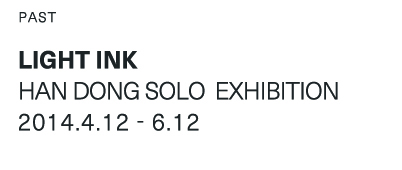
Exhibition time: 2014/4/12-2014/6/12
Venue:Renke Art Centre
In his creation, Han Dong weakened the elements of traditional ink painting, such as the thickness, heaviness, lightness and so on. He referred to small freehand brushworks, retaining the white space of the traditional Chinese ink painting, using rubbing and shading techniques to reveal the quietness behind the hustle. This is the artist Han Dong's unique and representative ink painting expression.

HAN DONG
.jpg)
1958, born in Dafeng, Jiangsu;
1986, graduated from Crafts Department from Nanjing Academy of Fine Art
Currently lives and works in Yangzhou, Jiangsu.
Solo Exhibitions
2014, Color of Emptiness and Shadow of Ink, curated by Chen Xiaoxin, Renke Art Gallery, Hangzhou;
2013, Tune like a Dream – Chapter Two, Gengsi Art Museum, Nanjing;
2012, Consciousness and Absolute Mind, OFOTO Gallery, Shanghai;
1999, Body Fable: Han Dong’s Painting, Nanjing Classic Auction House, Nanjing;
1993, first solo exhibition was held in Nanjing Academy of Fine Art Museum;
Group Exhibitions
2013, Nowhere to Rest: Jiangsu Contemporary Art Research Exhibition, Zhejiang Art Museum, Hangzhou;
2012, Depart from Nanjing: Exhaustion and Extension Exhibition, Sanchuan Modern Art Museum, Nanjing;
2012, The Sun: Contemporary Art Exhibition, OFOTO Gallery, Shanghai;
2009, Yi Pai – Century Thinking Art Exhibition, curated by Gao Minglu, Today Art Museum, Beijing;
2007, Journey to the West Art Exhibition, curated by Zuo Jing, Kunstraum Noe Niederösterreichische Museum, Vienna Austria;
2007, Chinese Version Modern Art Exhibition, curated by Chen Xiaoxin, Today Art Museum, Beijing;
2006, Poetic Realism: A Reinterpretation of Jiangnan Exhibition, RCM Art Museum, Nanjing;
2003, Chinese Art Today exhibition, China Millennium Monument, Beijing;
2000, Back to the Start, Aura Gallery, Shanghai;
1997, painting Clean Hands was selected in Chinese Contemporary Oil Painting Exhibition, Shanghai;
1997, Marginal Vision Second Exhibition, Beijing Contemporary Art Museum, Beijing;
1996, Marginal Vision: the First Exhibition of Jiangsu Young Artists, Jiangsu Provincial Art Museum, Nanjing;
1995, painting Inside Sandalwood Room was selected in the third Chinese Oil Painting Exhibition, China Museum of Art, Beijing;
1992, 1st Guangzhou Art Biennale (oil painting section), won the third prize;
1990, painting Listening to Qin was selected in Chinese Art Exhibition in Hongkong;
1986, 1st Lacquer Painting Exhibition in China, won the Award of Excellence.
PREFACE
Color of Emptiness and Shadow of Ink
Text/Chen Xiaoxin
Confucius said: flamboyance at extreme will return to insipidity and simplicity at last. On the surface, Han Dong's Paintings seem like just pale emptiness, cold, even quiescent ink and brushes. However, besides its shadowy appearance, the wilderness, the nursery garden, the industrial buildings, the roads and highways... are discernible. But there is no living creature in the paintings (people or birds or animals). This can be considered to be an intention of disassociation. In the eyes of the artist, perhaps only emptiness, not a soul in sight, no birds, no beasts, could be more detached from the pragmatic routines and the hustle and bustle of life. Thus one can get closer to his/her inner world.
In 1937, Duchamp put forward a concept of “infra-mince” (then extended to "infra-object"), his original intention is to use the “infra – mince” or "infra-object", transiting from the 2cd and 3rd dimension, eventually reach to an invisible, subtle fourth dimension (or time). So when we "reflect on" (Lao tzu) these batch of works, what we see, is not only a scene or an object, but also the "traces" of the time’s lingering and denudation, a memory, or a past. And what’s beyond, is a sympathetic pair of eyes, a compassionate heart...
In the process of creation, Han Dong adopted the mediums of moving image and photography. He also kept the tradition, using the authentic small freehand brushwork in the traditional Chinese ink painting. However, finally he utilized the techniques of steeping, covering, dyeing, he deliberately hided the brushes-and-ink in his paintings, in order to achieve an effect close to "no brush and no ink". By this means, a blurred, misty image was gradually surfaced.
Therefore, the pale emptiness does not mean feebleness, there is a kind of thickness, a kind of indescribable richness hidden behind it. It is similar to Chinese landscape paintings of the song dynasty, void and misty, deep and remote, unemotional and natural.
Watching them on a deeper spiritual level, just as Buddhist puts it: “all reality is a phantom and all phantoms are real” (色则是空,空即是色). Another saying is: “a subtle scene is solemn” (妙相庄严). It is exactly what is called the color of emptiness and shade of ink, a natural flow of rhythm.
I hope every sensible spectator, could enjoy the art of Han Dong, and simultaneously, attain a sort of spiritual sublimation and freedom.
These are my forewords.
—— Chen Xiaoxin
RALATED LINKS
huadong.artron.net/20140417/n592960.html
xh.xhby.net/mp2/html/2013-10/19/content_878031.htm
finance.ifeng.com/a/20131019/10888948_0.shtml
news.ifeng.com/gundong/detail_2014_04/13/35724479_0.shtml
VIDEOS
v.qq.com/x/page/y0128vmiybg.html
v.qq.com/x/page/y0129sdyq7e.html
FOLLOW US ON FACEBOOK
PLEASE SEARCH PAGE: Renke Gallery